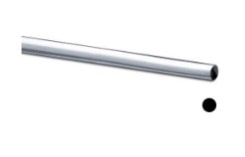 Round wire is the most common wire shape used and is the ‘standard’ shape in most wire working. Round wire is often used for a form of wire art known as Wire Weaving. Round wire is an excellent wire for making findings such as earring hooks and jump rings.
Round wire is the most common wire shape used and is the ‘standard’ shape in most wire working. Round wire is often used for a form of wire art known as Wire Weaving. Round wire is an excellent wire for making findings such as earring hooks and jump rings.
Square wire is chosen mostly for aesthetic reasons. Square wire can appear more ‘formal’ or  even ‘masculine’. It’s wonderful for wire wrapping pendants in traditional form. It’s also wonderful for making bracelet cuffs or formal rings. The flat sides of square wire will lay flush in a way that round wire can not. This makes square wire a favorite or ‘traditional’ wire when creating banding type designs. Square wire can be ‘twisted’ to create scalloped wire. This also hardens the square wire.
even ‘masculine’. It’s wonderful for wire wrapping pendants in traditional form. It’s also wonderful for making bracelet cuffs or formal rings. The flat sides of square wire will lay flush in a way that round wire can not. This makes square wire a favorite or ‘traditional’ wire when creating banding type designs. Square wire can be ‘twisted’ to create scalloped wire. This also hardens the square wire.

Half round wire has a flat side and a rounded side. The flat side is used to lay against the square wires. The rounded side of half round wire remains exposed to design.
Wire Metals
Silver wire comes in several form:
.999 Fine Silver – Fine silver is pure silver at 99.9% silver. It does not tarnish and is very very soft. It is excellent metal for making very elaborate or ‘curly’,’swirly’ designs as it is soft enough to bend easily with the hands.
.925 Sterling Silver – Sterling silver is a silver alloy of 92.5% silver and 7.5% copper. The copper makes the silver harder and more durable but also causes the silver to tarnish over time.
Argentium silver 935 is a modern sterling silver alloy, containing 93.5% silver. The traditional sterling alloy (92.5% silver + 7.5% copper) is modified by removing some of the copper and adding the metalloid germanium.
Argentium silver 960 is a higher-purity jewellery alloy also containing germanium. It meets the standard for Britannia silver (95.84% silver) hallmarking.
Argentium is a tarnish-resistant alloy, which means less time polishing!
Silver Fill & Gold Fill, also called ‘Rolled’ Gold or Overlay. These wires are created by using a heat and pressure to apply thick layers of precious metal to a base or ‘core’ of less costly metals. This type of wire is good for making upper-end but more economical designs. Fill/Overlay is typically considered precious metal, despite not being solid because the precious metal ‘surface’ contacts much more of the precious metal than a normal plating. It will ‘wear’ and behave more like a solid precious metal than a plate will.
Silver Plate & Gold Plate Wires give options to match precious metal components or colors, without the added cost.
- A disadvantage of using plated metal is that it can become chipped or cracked if over worked.
- Over time and over regular ‘wear’, a plate might rub off, exposing the base metal underneath.
Memory wire is normally considered a crafting wire and is very hard and already pre-formed into a very stable ‘coil’. It works great for making wine glass charms, multi-wrap beaded bracelets and napkin rings.
Enamel-Coated Wires or ‘Color Coated’ wires offer a rainbow of color that doesn’t normally chip or crack. Artistic Wire is a leading brand and is ‘colored coated copper wires’.
- While these wires are wonderful and fun to works with, if they are nicked by the pliers, the under copper color can show. It can show at the cut ends also.













